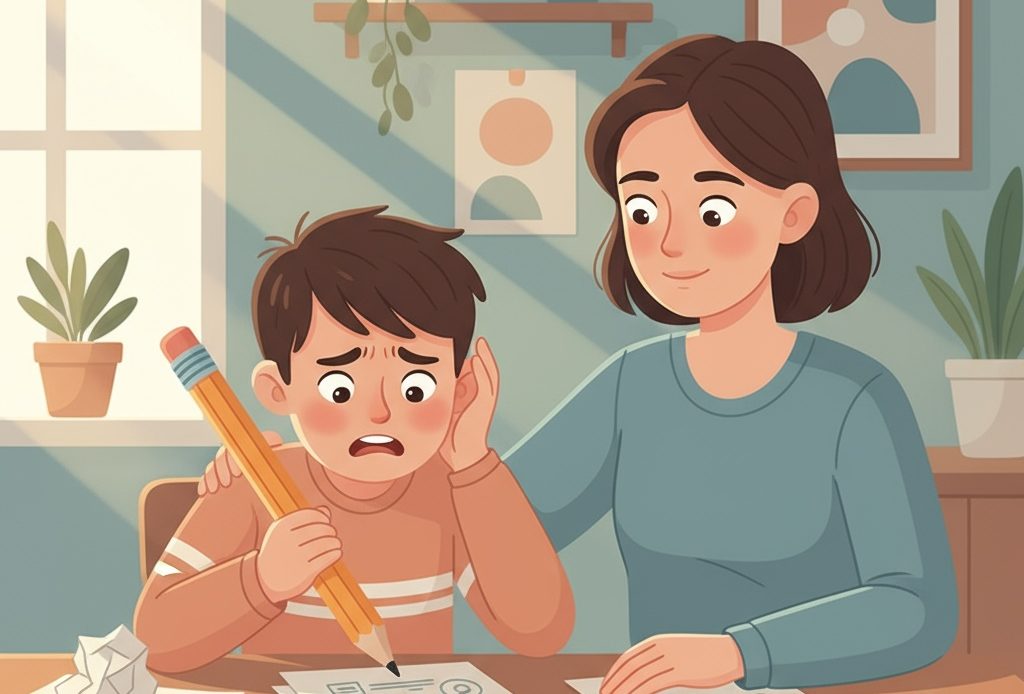
Your child’s hand trembles as they erase the same line for the fifth time. “It’s not perfect,” they whisper, their voice tight with frustration. You watch them tear up the entire page and start over. It’s a simple homework assignment, but to them, it’s a test they’re failing. And they’re only in Year 4.
Perfectionism in children looks like excellence on the surface. Teachers praise it. Parents often encourage it. But underneath, it’s a prison. Perfectionist children are trapped in a cycle of impossibly high standards, crushing self-doubt, and paralyzing fear of failure. And here’s what most parents don’t realize: perfectionism and anxiety are deeply intertwined. In fact, perfectionism is one of the most common underlying drivers of childhood anxiety.
As a psychologist who’s worked with hundreds of anxious children, and as a mother who’s watched perfectionism steal joy from my own kids, I can tell you this: perfectionism isn’t about wanting to do well. It’s about the terror of not being good enough.
In this guide, I’ll help you understand the roots of perfectionism in children ages 8-12, recognize the signs that perfectionism is becoming problematic, and learn practical strategies to help your child break free from the perfectionism-anxiety trap. Because your child’s worth isn’t determined by their performance—and they need to know that.
What Is Perfectionism? (And Why It’s Different From High Standards)
Let’s start with an important distinction: there’s a difference between healthy striving and perfectionism.
Healthy Striving: Your child wants to do well. They set reasonable goals, work toward them, and feel satisfied when they achieve them. If they fall short, they’re disappointed but resilient. They learn from mistakes and move forward. They can celebrate effort even when the outcome isn’t perfect.
Perfectionism: Your child’s self-worth is entirely dependent on performance. Mistakes feel catastrophic. “Good enough” doesn’t exist—only perfect or failure. They set impossibly high standards, then beat themselves up when they can’t meet them. They avoid challenges because the risk of failure is unbearable. They ruminate over small mistakes for days. Effort doesn’t matter; only flawless results count.
The perfectionist child isn’t motivated by joy or curiosity. They’re driven by fear: fear of failure, fear of judgment, fear of not being good enough.
Here’s the critical connection to anxiety: Perfectionism and anxiety feed each other. Perfectionist standards create anxiety (the pressure to be perfect is exhausting). Anxiety then reinforces perfectionism (if I’m not perfect, something bad will happen). It’s a vicious cycle.
Why Do Children Develop Perfectionism?
Perfectionism doesn’t appear out of nowhere. It develops from a combination of factors:
1. Temperament & Genetics
Some children are naturally more conscientious, detail-oriented, and sensitive to criticism. They’re wired to notice mistakes and feel distressed by them. If a parent or sibling also struggles with perfectionism, children often internalize this as “the way things should be.”
2. Parental Modeling & Messaging
Children learn perfectionism by watching adults around them. If you model perfectionism—constantly criticizing your own performance, apologizing for minor mistakes, or expressing anxiety about not being good enough—your child absorbs this as normal. Even well-intentioned praise can reinforce perfectionism: “You’re so smart!” (conditional on performance) versus “You worked really hard on that” (conditional on effort).
3. High Parental Expectations
When parents consistently communicate that love, approval, or pride is conditional on achievement, children internalize the message: “I’m only worthy if I’m perfect.” This doesn’t require harsh criticism. It can be as subtle as always expecting A’s, showing disappointment at B’s, or frequently comparing your child to siblings or peers.
4. School Environment & Achievement Culture
Modern schooling often emphasizes grades, rankings, and competition. Children receive constant feedback on their performance. Standardized testing, academic pressure, and the visibility of achievement (class rankings, honor rolls) can intensify perfectionist tendencies. Perfectionist children internalize the message: “Your value = your grades.”
5. Neurodivergence
Children with ADHD, autism, anxiety disorders, or learning differences often develop perfectionism as a coping mechanism. They might think: “If I can’t control my ADHD, at least I can control my grades.” Or: “If I’m not perfect, people will discover I’m different/broken.” Perfectionism becomes a mask.
6. Trauma or Unpredictability
Children who’ve experienced instability, criticism, or conditional love sometimes develop perfectionism as a way to regain control. If they can just be perfect enough, maybe they can prevent bad things from happening or earn the love they need.
Signs Your Child’s Perfectionism Is Becoming Problematic
All children want to do well sometimes. But problematic perfectionism shows up as a consistent pattern. Watch for these signs:
Academic Perfectionism:
- Spending hours on homework that should take 30 minutes because “it’s not good enough”
- Erasing and rewriting repeatedly; tearing up work that has minor errors
- Extreme distress over grades (crying over a B, spiraling after a mistake on a test)
- Avoiding challenging assignments or new subjects where they might not excel immediately
- Asking for constant reassurance: “Is this good enough? Did I do it right?”
- Comparing grades obsessively to peers
Social Perfectionism:
- Extreme anxiety about social situations; fear of saying the “wrong thing”
- Avoiding social activities or new friendships due to fear of rejection or judgment
- Difficulty making mistakes in front of others; shame or humiliation if they do
- People-pleasing to the point of exhaustion; inability to say no
- Ruminating over social interactions for days: “Did they think I was weird?”
Physical/Athletic Perfectionism:
- Extreme frustration when learning new physical skills; giving up quickly if not “natural”
- Avoiding sports or activities where they might not be the best
- Obsessive practice to the point of injury or burnout
- Harsh self-criticism about their body or athletic performance
General Perfectionism Signs:
- Frequent negative self-talk: “I’m stupid,” “I’m not good enough,” “I always mess up”
- Difficulty accepting compliments or praise
- Procrastination (perfectionism often masks as laziness—they delay starting because they’re terrified of not doing it perfectly)
- Physical symptoms: stomachaches, headaches, tension before performance situations
- Anxiety, irritability, or emotional meltdowns when things don’t go as planned
- Perfectionism in one area spreading to others (if they’re perfectionist about grades, it extends to appearance, sports, friendships)
- Difficulty with transitions or changes (perfectionism thrives on control; uncertainty triggers anxiety)
The most telling sign: Your child’s self-worth fluctuates dramatically based on performance. After a success, they’re elated. After a perceived failure, they’re devastated. This emotional volatility is exhausting for them and for you.
The Perfectionism-Anxiety Connection
Why is perfectionism such a powerful driver of childhood anxiety? Because perfectionism creates constant threat.
The perfectionist child’s internal experience is something like this:
“If I’m not perfect, I’ll fail. If I fail, people will judge me. If they judge me, I’m not good enough. If I’m not good enough, I’m unlovable. Therefore, I must be perfect at all times, or everything will fall apart.”
This is exhausting. And it’s anxiety-producing.
Research shows that perfectionism is strongly correlated with anxiety, depression, and eating disorders in children. Perfectionist children have higher rates of:
- Generalized anxiety disorder
- Social anxiety
- Performance anxiety
- Obsessive-compulsive tendencies
- Depression and low self-esteem
The good news? When you help your child loosen their perfectionist standards, anxiety naturally decreases. The two are so intertwined that reducing perfectionism is one of the most effective ways to reduce anxiety.
How to Help Your Child Break Free From Perfectionism
Strategy 1: Model Healthy Imperfection
This is the most powerful intervention. Children learn from what they see, not what you tell them.
Start making your own imperfections visible:
- Make a mistake in front of your child and laugh about it: “Oops, I burned the toast! Oh well, that’s what happens when I’m distracted.”
- Share your own learning process: “I’m trying to learn this new skill and I’m terrible at it right now. But that’s okay—everyone starts somewhere.”
- Normalize failure: “I didn’t get that promotion. I’m disappointed, but it’s not a reflection of my worth.”
- Show effort over outcome: “I worked really hard on that project even though it didn’t turn out perfectly. I’m proud of my effort.”
- Accept compliments gracefully without deflecting: Instead of “Oh, it’s nothing,” say “Thank you, I appreciate that.”
When your child sees you handling mistakes with grace and humor, they learn that imperfection isn’t catastrophic.
Strategy 2: Shift Praise From Outcome to Effort
This is backed by decades of research (Carol Dweck’s “growth mindset” work). How you praise your child shapes their beliefs about ability and failure.
Instead of: “You’re so smart! You got an A!”
Say: “You worked really hard on that. I noticed you kept trying even when it was difficult. That’s what learning looks like.”
Instead of: “You’re naturally talented at soccer.”
Say: “You’ve been practicing consistently and it’s paying off. Your effort is making a difference.”
Instead of: “Perfect job!”
Say: “I see you put thought into this. What part are you most proud of?”
Effort-based praise teaches children that ability grows through practice, mistakes are part of learning, and their worth isn’t tied to flawless performance.
Strategy 3: Reframe Mistakes as Learning Opportunities
Perfectionist children catastrophize mistakes. Your job is to normalize them.
When your child makes a mistake:
Validate the feeling: “I know you’re frustrated. Mistakes feel really disappointing when you care about doing well.”
Normalize the mistake: “Everyone makes mistakes. That’s how brains learn. Your brain is literally rewiring itself right now based on this mistake.”
Find the learning: “What can we learn from this? What would you do differently next time?”
Move forward: “Okay, let’s try again. I believe in you.”
This teaches your child that mistakes aren’t character flaws—they’re data. They’re information. They’re part of growth.
Strategy 4: Set Realistic, Flexible Standards
Help your child distinguish between “good enough” and “perfect.”
For homework: “Your job is to do your best effort. Perfect isn’t the goal—learning is. If you’ve spent 30 minutes and you understand the concept, that’s done.”
For appearance: “Your hair doesn’t need to be perfect. You need to feel comfortable and be yourself.”
For social situations: “You don’t need to say the perfect thing. You just need to be genuine.”
This might feel uncomfortable at first—perfectionist children often resist “good enough.” But with consistent messaging, they learn that standards can be flexible without everything falling apart.
Strategy 5: Gradually Expose Them to “Imperfect” Situations
Perfectionism thrives on avoidance. The more your child avoids situations where they might not be perfect, the more anxiety grows.
Gently encourage exposure to imperfection:
- Try a new sport or activity where they’re a beginner (and will definitely make mistakes)
- Join a group or class where they don’t know anyone (social risk)
- Attempt something challenging where failure is possible
- Share something they created that isn’t perfect (art, writing, ideas)
The key is gradual and supported. Don’t force them into high-stakes situations. Start small. Stay calm. Celebrate the courage it took to try, regardless of the outcome.
When they survive an imperfect situation and the world doesn’t end, their brain learns: “Imperfection isn’t dangerous.”
Strategy 6: Address Underlying Anxiety
Remember: perfectionism is often anxiety in disguise. If your child has significant anxiety, treating the anxiety will help reduce perfectionism.
Use the emotional regulation techniques from our previous guide: grounding, breathing, cognitive restructuring, gradual exposure to fears. These directly address the anxiety driving the perfectionism.
Strategy 7: Examine Your Own Perfectionism
This is the hardest but most important strategy. Children internalize parental perfectionism.
Reflect on:
- Do you model perfectionism? (Constant self-criticism, difficulty accepting mistakes)
- Do you communicate conditional love? (Praise only for achievement, disappointment at “failure”)
- Do you compare your child to others? (Even subtle comparisons send the message that they need to be better)
- Do you have unrealistic expectations? (Expecting straight A’s, specific achievements, or particular outcomes)
- Do you struggle with anxiety? (Anxiety and perfectionism often run in families)
You don’t need to be perfect at parenting. In fact, showing your child that you’re working on your own perfectionism is one of the most powerful lessons you can teach.
When to Seek Professional Help
Perfectionism is treatable, and many children improve significantly with parental support and the strategies above. However, consider consulting a psychologist if:
- Perfectionism is significantly interfering with school, friendships, or family life
- Your child is experiencing depression, eating disorders, or self-harm related to perfectionism
- Perfectionism is worsening despite your efforts
- Your child has OCD or other anxiety disorders alongside perfectionism
- You feel overwhelmed or unsure how to help
Cognitive Behavioral Therapy (CBT) is highly effective for perfectionism. A therapist can help your child challenge perfectionist thoughts, gradually face fears of imperfection, and build self-worth independent of performance.
The Freedom Beyond Perfectionism
Perfectionism feels like protection. It feels like the way to be safe, to be loved, to be worthy. But it’s actually a cage.
When you help your child escape perfectionism, something beautiful happens. They start to take risks. They try new things. They make friends without rehearsing conversations. They create art without erasing it obsessively. They fail and get back up. They discover that their worth isn’t determined by their performance.
They discover who they actually are underneath the perfectionism. And that person? They’re already enough.
Your child doesn’t need to be perfect. They need to know they’re loved unconditionally. They need to see that mistakes are part of being human. They need permission to be imperfect and still be worthy.
That’s what breaks the perfectionism-anxiety cycle. And that’s what sets them free.




